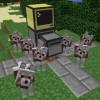
5 posts
Posted 11 January 2013 - 10:28 AM
Hey gang,
I'm playing around with a program that will need to manage a great volume of redstone outputs. I've got a "screen" composed of in total 1.296 blocks (48x27), each one being a different pixel.
Obviously, bundled cables don't come close to supporting this kind of output, so I'm looking for suggestions. Using a (partial) analog signal timed to sync each pixel in sequence comes to mind, but it seems impractical due to latency.
Any ideas?

264 posts
Location
Where you aren't
Posted 11 January 2013 - 10:34 AM
Lots of bundled cable and lots of computers. You can't do this without a lot of computers.

139 posts
Location
USA
Posted 11 January 2013 - 10:50 AM
Just an idea: Output 1 = white and orange. Output 2 = white and magenta. Output 3 = white and lightBlue… and so on. Or if are needed then you just and 3 colors together. Is there a way to implement that? Because that would only need 1 computer to control it all but probably a lot of wires.

7508 posts
Location
Australia
Posted 11 January 2013 - 11:22 AM
Not quite sure I understand the full use case here but I'll still give it a go… What do the redstone outputs go to? other computers? If so I think the easiest way (least amount of coding and footprint)… Have ONE bundled cable running to them all. then send them rednet signals through the bundled cable. if its for actual output I suggest a similar setup but have each computer in charge of 16 outputs and a rednet message to that computer encoding the colours to display in the message…

78 posts
Location
Poland
Posted 11 January 2013 - 12:01 PM
I think that he wants to make refreshing screen like real world, so like this
1st step - all lines off but first
2nd step - all lines off but second
and so on
That way he can have one bundled cable to select line and second(or more) to control pixels.
But I think, that this will be impossible in minecraft, cause it will be flickering like crazy(due to tickrate - only 20 per second).
BUT you can make memory for screen and use it like a buffer, then you'll be able to make something like below:
- set memory row to 0
- set output cables to value
- set write bit to memory
- reset write bit to memory
- set memory row to 1
- set output cables to value
- set write bit to memory
- reset write bit to memory
and so on



